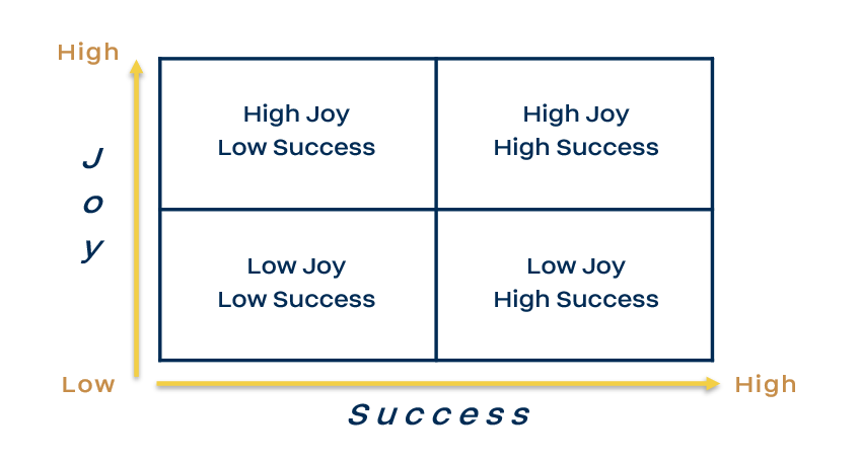By now we’re familiar with the terms and statistics describing our workplaces as we emerge from the pandemic: the Great Resignation, the Great Reflection, Quiet Quitting and others. While data suggests the percentage of workers leaving their jobs is starting to decrease, it’s likely there are still plenty of employees at your company considering other opportunities.
As talent leaders, we’re tasked with exploring engagement strategies to keep turnover at bay. If we think about how we would decide whether to stay or go when offered a new opportunity, it can lead us to more effective ways to keep our employees engaged where they are now.
As I reflect on my career, I see there were common elements to the “love this job” roles and the “I’m open to new opportunities” roles. As I charted the different characteristics, I realized they fell into two broad buckets: joy and success. What strategies might we implement that would increase our employees’ sense of joy and success and minimize the chance that they’ll explore greener grasses?
JOY
Some call this “happiness,” others might call it passion; I prefer the simplicity of asking: “Am I deriving joy from the time I spend in this role? How much joy am I experiencing?” How do you think employees in your firm would rate these elements of joy?
Community / relationships
Would they feel like they are part of a community at work? Do they have relationships with coworkers they look forward to spending time with? Or, conversely, do they feel like they’re excluded from the “inner circle,” or that the culture is the kind that has them wondering if their peers have their back?
Challenge
Would they say their job is like “Groundhog Day,” or is there sufficient challenge and variety in their roles? In other words, are they on autopilot or is there at least an occasional change of pace from new projects, a new customer, or a new competitor?
Fun / passion
When’s the last time employees did something at work they’d describe as fun? And while after-work socializing or back-to-office celebrations count, could they identify any of their work deliverables as “fun?”
Discretionary time
The more engaged people are, the more “extra” time they’re willing to give to the role. This is time they don’t even notice, or if they do notice, they don’t mind the extra time they think about their job outside of normal “working hours.” This is the opposite of “quiet quitting,” in which workers decide to work only the 35-40 hours they are paid for, nothing more.
Values match
Those familiar with the Hogan assessment know that people are more satisfied, and likely to stay, in environments that are consistent with their own values. When employees see why and how their co-workers get rewarded, is it for reasons that feel right to them?
Family reaction
How often do you think your employees tell their family members about their work or your company, because they’re so proud of what they do or what the company does? What can you promote that they’d tell their families about?
SUCCESS
The second bucket involves gauging how much success people are experiencing in their current role, and more importantly, how successful they believe they can be over time, say, over the next 18 months to two years. Here are factors that can help assess sustainable success:
Resources / capabilities
Do they have what they need to accomplish the goals they’ve been assigned or have agreed to accomplish? Examples include budget, adequate time, staff, access to support and clarity of priorities. In addition, do they have the skills they need to be successful? If not, do managers in your organization support their development, so they can build the skills or gain the exposure and experience they need to succeed? Would they say this is likely to increase or decrease over the next two years?
Visibility
Are your employees aware of the concept of “personal brand” and are they able to develop it? What if they were coached on how to appropriately increase their visibility and reputation? Offering lunch and learn sessions on how build your network, gain exposure, and build your brand will likely be well received. If your employees see that your company is willing to develop this “organizational savvy,” the more they’ll be invested in staying.
Compensation
While some would put this at the top of the list as a major component of the Success bucket, it’s only one of many, but clearly a significant one. Do your employees have cause to believe their pay is fair? Do they know how pay ranges work such that they’d find it reasonable to expect to receive increases in their compensation in the next two years if they work hard?
Clear path of growth / succession
Pay may be an indicator of current success, but employees may be looking ahead to see if / where they could continue to grow with your current firm. Where can they see themselves in two years? Where do they want to be and is it realistic to expect they could reach their aspirations, assuming their work and reputation are solid? Is their only path to succeed their manager, who may not appear to be going anywhere? Do they know how many employees are promoted from within vs. hired externally? This is a key statistic to share to demonstrate your company’s commitment to internal mobility. How comfortable are they with having conversations with their managers about career paths and how they can develop capabilities to be ready for opportunities when they present themselves?
Motives / preferences match
The Hogan assessment acknowledges the importance of aligning motives and preferences with the careers and roles employees currently hold. For example, if employees prefer a flexible work environment and that isn’t offered, or they are motivated by community involvement but their boss or company frowns on this, they’re not likely to be content for long. The more of a mismatch there is between their preferences and the actual atmosphere at your workplace, the less likely they’ll be successful over time. Is there a way, using surveys or focus groups, to understand evolving preferences?
Manager relationships
This might be number one on some people’s lists, given we’ve all heard that people don’t leave companies, they leave bad bosses. To put it bluntly, you can be a great performer, but you aren’t likely to succeed if you’re working for a poor manager. To what extent do employees think managers take the credit for their work? Do they think their managers have their back when they make a mistake? What’s the current trust level between employees and their managers?
The joy/success matrix
When we place Joy and Success on a 2×2 matrix, it provides a guide to whether employees are likely to stay in their current roles or explore making a change:

High Joy / High Success: This one’s simple – if their job brings them a high level of joy and they feel they will continue to succeed, then when they get that call from a recruiter, they’ll probably take a pass.
Low Joy / Low Success: If employees are experiencing little joy from their jobs, they don’t believe they are likely to succeed and they have the ability to find another role, they may be actively in a job search. Those who feel trapped in a “low joy/low likelihood of success” role, and don’t have the time or resources to explore other opportunities, are those most likely to “quiet quit,” i.e., give the minimum amount of effort required to keep getting paid.
The other two quadrants set up choices that are less predictable:
Low Joy / High Success: Employees may feel successful and things may be looking rosy for them for the foreseeable future. But are they ending their workday with nothing else to give? Are their personal relationships suffering? Are they experiencing burnout? Of the four quadrants in the Joy/Success Matrix, this one was arguably most impacted by the pandemic. Many otherwise successful people realized they weren’t experiencing joy in their jobs anymore and began to confront the brevity of their lives. Many decided life was too short not to focus on work that really mattered to them, if they had a choice in the matter. What can we do to make employees experience more joy in their day-to-day experiences?
High Joy / Low Success: “Low Success” doesn’t mean employees think they aren’t successful currently. They might be doing just fine, but how do things look to your employees over time? Has a new leader joined the firm with a different style? Is the company’s technology shifting such that current skillsets are increasingly less valuable? Are people feeling asked to do a lot more, with fewer resources? Do they believe there’s no other opportunity for them to grow if they stay? Show them how to maintain and build their network. Show them what they can do to explore internal opportunities if they present themselves. Many employees aren’t aware of their company’s external job postings. Why not?
Given that high levels of joy and perception of continued success are reasons employees will stay in their current roles, what can we do in our organizations to ensure these factors are leveraged or multiplied? Can we ask what career paths they’re interested in, and develop action plans to increase readiness? Can we arrange work or experiences that build relationships?












